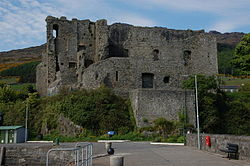King John's Castle, Carlingford
| King John's Castle | |
| County Louth | |
|---|---|
 King John's Castle | |
| Type: | Enclosure castle |
| Location | |
| Grid reference: | J18811195 |
| Location: | 54°2’35"N, 6°11’13"W |
| Town: | Carlingford |
| History | |
| Built late 12th century | |
| Information | |
| Owned by: | Heritage Ireland |
King John's Castle, also known as Carlingford Castle, is an enclosure castle in Carlingford, County Louth.
The castle is designated as a 'National Monument' and is now in state care.
King John's Castle strands in Carlingford town's harbour, halfway along the south coast of Carlingford Lough.
History
Carlingford Castle's west wing was built in the late 12th century by Hugh de Lacy, Lord of Meath shortly after the Norman invasion of Ireland. It acquired the name "King John's Castle" after King John, Lord of Ireland, supposedly stayed there for three days in 1210, during his second expedition, when he invaded Ulster to apprehend Hugh de Lacy, 1st Earl of Ulster. Local myth claims that he began to draft Magna Carta (agreed in 1215) at Carlingford.[1] Other accounts associate its construction with Ralph Pepper in 1204.[2]
The east wing of the castle was added c. 1261. In 1326 the castle was committed to Geoffrey le Blound. Edmond Loundres was constable in 1388, Stephen Gernon in 1400. Henry MacShane O'Neill attempted to take the castle in 1596.
During the Irish Confederate Wars, the castle was held by the Irish Catholic Confederation; then was taken by Sir Henry Tichborne, 3rd Baronet (for Parliament) in 1642, then by Murrough O'Brien, 1st Earl of Inchiquin in 1649 and Charles Coote, 1st Earl of Mountrath in 1650.
In 1689 at the beginning of the Jacobite War, the castle was fired on by Jacobites. General Schomberg, in command of the forces of King William III, used the castle as a hospital before the Battle of the Boyne.[3][4]
Building

King John's Castle is a D-shaped enclosure castle with walls 11 feet thick.[5] The curtain wall in the west wing had a gate house and a square flanking tower. The curtain wall also contains deep embrasures with narrow arrowslits.
A large rectangular hall is in the east wing: this hall had two main floors over a basement.[6]
References
- ↑ O'Dwyer, Francis. "Irish American Post". http://www.gaelicweb.com/irishampost/year2010/summer/featured/featured01.html.
- ↑ Pepper, George (1 January 1829). "The Irish Shield and Monthly Milesian". s.n.. https://books.google.ie/books?id=2TQNAAAAYAAJ&pg=PA337&dq=King%20John's%20Castle%20(Carlingford&hl=en&sa=X&ved=0ahUKEwiV-u-K5arPAhXiAcAKHUTTAtkQ6AEIPjAH#v=onepage&q=King%20John's%20Castle%20(Carlingford&f=false.
- ↑ "Castles.nl - Carlingford Castle". http://www.castles.nl/carlingford-castle.
- ↑ "Castle works progress - Independent.ie". http://www.independent.ie/regionals/argus/news/castle-works-progress-31177882.html.
- ↑ Grose, Francis (1 January 1795). "The antiquities of Ireland". Printed for S. Hooper. https://books.google.ie/books?id=Y4pZAAAAYAAJ&pg=PT29&dq=King%20John's%20Castle%20(Carlingford&hl=en&sa=X&ved=0ahUKEwiV-u-K5arPAhXiAcAKHUTTAtkQ6AEIODAG#v=onepage&q=King%20John's%20Castle%20(Carlingford&f=false.
- ↑ "1200 - King John's Castle, Carlingford, Co. Louth - Architecture of Louth - Archiseek - Irish Architecture". 6 January 2010. http://archiseek.com/2010/king-johns-castle-carlingford-co-louth/.
- Dixon, Philip: 'King John's Castle, Carlingford' in The Dublin Penny Journal 1 January 1832; via Google Books